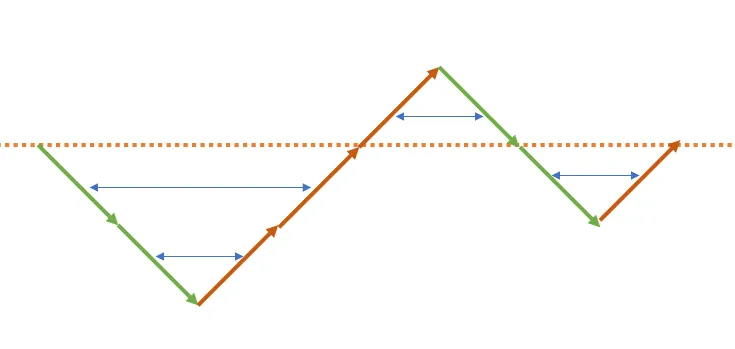题目 | Bracket Coloring
Educational Codeforces Round 149 (Rated for Div. 2)
D. Bracket Coloring
https://codeforces.com/contest/1837/problem/D
2 seconds / 512 megabytes
standard input / standard output
Problem
A regular bracket sequence is a bracket sequence that can be transformed into a correct arithmetic expression by inserting characters "1" and "+" between the original characters of the sequence. For example:
- the bracket sequences "()()" and "(())" are regular (the resulting expressions are: "(1)+(1)" and "((1+1)+1)");
- the bracket sequences ")(", "(" and ")" are not.
A bracket sequence is called beautiful if one of the following conditions is satisfied: - it is a regular bracket sequence;
- if the order of the characters in this sequence is reversed, it becomes a regular bracket sequence.
For example, the bracket sequences "()()", "(())", ")))(((", "))()((" are beautiful.
You are given a bracket sequence $s$. You have to color it in such a way that:
- every bracket is colored into one color;
- for every color, there is at least one bracket colored into that color;
- for every color, if you write down the sequence of brackets having that color in the order they appear, you will get a beautiful bracket sequence.
Color the given bracket sequence $s$ into the minimum number of colors according to these constraints, or report that it is impossible.
Input
The first line contains one integer $t$ ($1 \le t \le 10^4$) — the number of test cases.
Each test case consists of two lines. The first line contains one integer $n$ ($2 \le n \le 2 \cdot 10^5$) — the number of characters in $s$. The second line contains $s$ — a string of $n$ characters, where each character is either "(" or ")".
Additional constraint on the input: the sum of $n$ over all test cases does not exceed $2 \cdot 10^5$.
Output
For each test case, print the answer as follows:
- if it is impossible to color the brackets according to the problem statement, print $-1$;
- otherwise, print two lines. In the first line, print one integer $k$ ($1 \le k \le n$) — the minimum number of colors. In the second line, print $n$ integers $c_1, c_2, \dots, c_n$ ($1 \le c_i \le k$), where $c_i$ is the color of the $i$-th bracket. If there are multiple answers, print any of them.
Example
Input
4
8
((())))(
4
(())
4
))((
3
(()
Output
2 2 2 1 2 2 2 1
1
1 1 1 1
1
1 1 1 1
-1
题解
重点一:何时无解
这一点还是比较容易发现的,即 ( 的数目与 ) 的数目相同时有解,不同时无解。
因为对于合法的括号组,正括号与反括号的数量一定相同,这点说明数量不同时无解。
对于数量相同时是否一定有解这个问题,我们可以构造一个简单的合法解:随意挑选一对 ( 和 ),涂上相同的颜色,再挑选出一对,涂上和之前不一样的颜色,重复这个过程。最后所有括号一定会全部被拆分为单独的括号对,这种解一定合法(但是明显不是最优)
重点二:颜色数量
为了让问题更直观,我们将 ( 转换为 $+1$,将 ) 转换为 $-1$,那么序列 (()(())) 可以表示为:

我们可以发现,每层都可以用蓝色箭头连接一对括号,将每对括号匹配上。因此上述序列已经是合法的括号序列,可以全部涂成一种颜色。考察另外一个序列 )())()((,它可以表示为:

我们可以发现,每层的蓝色箭头仍然可以把每对括号匹配上,但是这次括号的顺序反了,不过它的逆序括号顺序就正了。因此也是合法的括号序列,可以全部涂成同一种颜色。综上,对于全部 $\leq0$ 和全部 $\geq0$ 的情况,可以全部涂成同一种颜色。接下来需要讨论的就是既有 $\leq0$ 也有 $\geq0$ 的情况:

对于 $\leq0$ 的情况,我们需要逆序;对于 $\geq0$ 的情况,我们不能逆序:因此这两种情况不可共存。那么我们可以将 $\leq0$ 的情况涂上一种颜色,$\geq0$ 的情况涂上另一种颜色,这样就能把二者隔离开了,并且两者都是合法的序列。
代码
#include <bits/stdc++.h>
#define endl '\n'
using namespace std;
void solve()
{
int n;
cin >> n;
string s;
cin >> s;
vector<int> a(n + 1);
bool pos = false, neg = false;
for (int i = 0; i < n; i++)
{
if (s[i] == '(')
a[i + 1] = a[i] + 1;
else
a[i + 1] = a[i] - 1;
if (a[i] > 0)
pos = true;
if (a[i] < 0)
neg = true;
}
if (a.back() != 0)
{
cout << -1 << endl;
return;
}
if (!(pos && neg))
{
cout << 1 << endl;
for (int i = 0; i < n; i++)
cout << 1 << ' ';
cout << endl;
}
else
{
cout << 2 << endl;
for (int i = 0; i < n; i++)
{
if (a[i] >= 0 && a[i + 1] >= 0)
cout << 1 << ' ';
else
cout << 2 << ' ';
}
cout << endl;
}
}
signed main()
{
ios::sync_with_stdio(false);
cin.tie(0);
cout.tie(0);
int t;
cin >> t;
while (t--)
solve();
return 0;
}本文采用 CC BY-SA 4.0 许可,本文 Markdown 源码:Haotian-BiJi